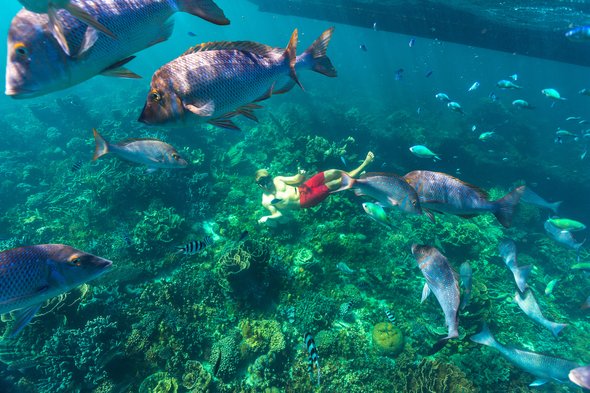Swimming with the whale sharks | Ningaloo Reef, WA / Aerial footage, Tourism Western Australia
Swim with whale sharks on Ningaloo Reef, WA

One of the few places on the planet where you’re able to swim alongside these gentle giants of the ocean, in the heart of the world’s largest fringing reef.

Setting out for a day of wonder
Tourism Western Australia

Coral Bay
Tourism Western Australia

Whale Shark, Ningaloo Reef
Credit: Luxury Lodges of Australia

Where is it?
Ningaloo Marine Park is off Exmouth in WA, 1200 km north of Perth.
What is the experience?
Swimming alongside whale sharks at Ningaloo Reef was one of the most awe-inspiring and humbling experiences of our lives; it leaves you with a full appreciation of why they are affectionately known as the gentle giants of the sea, and how privileged we are to have Ningaloo Reef in our backyard.
One of the world’s largest fringing reefs, World Heritage–listed Ningaloo Marine Park is brimming with marine life; manta rays, turtles, over 500 species of fish, and hundreds of varieties of colourful coral. Nowhere else can you see such a large coral reef so effortlessly, where humpback whales pass through on their annual migration, the world’s highest number of whale sharks congregate, and a rare turtle species hatches right on the beach.
Some of the longest-living creatures on earth, whale sharks can grow up to 12-ft tall and live for up to 70 years. With only around 400 of them left in the world, they are one of the most endangered species on the planet.
The Ningaloo/Nyinggulu Coastal Reserve is culturally significant to the Baiyungu, Thalanyji and Yinigurdira peoples, who have an ongoing connection to the area. The Baiyungu word ‘Nyinggulu’ means promontory.
Our day on the reef was filled with heightened adventure. It started with a warm-up snorkel on the fringing reef, followed by a full-scale operation with a spotter plane guiding the direction of our charter boat, and a team of passionate guides committed to sharing their knowledge for the protection of reef. As the whale shark was spotted, our boat came to a halt; everyone pointed to a fin some hundred metres away. Within minutes, our flippers and snorkels were on, and we found ourselves jumping off the back of the boat. Why so early? I kept wondering because the whale shark looked miles away. ‘Look down, look down,’ our guide smiled. There below us was an incredibly majestic creature.
The whale shark was gliding steadfast through the ocean, and our initial nerves were replaced with an overwhelming sense of calm. It felt like time stood still … and then as quickly as it had appeared, it disappeared deep into the ocean.
Back on the boat, words felt inadequate to match such an encounter. We were left silent, but committed to sharing the majesty of the whale shark, and the important work of environmentalists protecting our oceans.
How do you get there?
The Ningaloo whale shark migration is between April and July and it’s best to book ahead.
Book a tour with one of the local operators from Coral Bay, or Exmouth. Everything you need to swim with the whale sharks is provided onboard the boats, including snorkelling equipment, wetsuits, food and drinks and knowledgeable tour guides who are passionate about Ningaloo Reef.
How long should you stay?
Most reef and ocean tours can take up to a full day. We recommend staying in the area for five to seven days though, to make the most of your journey to this remote part of the world. You’ll find many attractions in Cape Range National Park, and you’ll need a national park pass for entry.